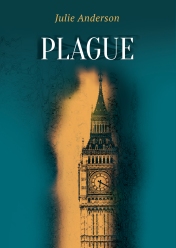 Plague (Claret Press, 2020) will be published on 15th September, in thirty eight days time. In the absence of much of the usual publicity and activity which attends such things because of COVID-19, the virtual campaign is assuming much greater significance. In preparation for various elements of this I was out and about in central London on Thursday with my friend and trusty photographer, Helen Hughes, making a visual record of some of the locations which feature in the novel. We were also tracing, in so far as we were able, the course of the ‘lost’ river Tyburn.
Plague (Claret Press, 2020) will be published on 15th September, in thirty eight days time. In the absence of much of the usual publicity and activity which attends such things because of COVID-19, the virtual campaign is assuming much greater significance. In preparation for various elements of this I was out and about in central London on Thursday with my friend and trusty photographer, Helen Hughes, making a visual record of some of the locations which feature in the novel. We were also tracing, in so far as we were able, the course of the ‘lost’ river Tyburn.
We began, rather appropriately, given the book’s title, with a bite of lunch in the Royal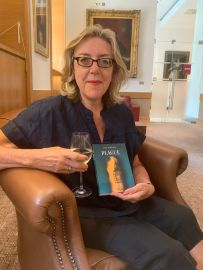 Society of Medicine on Wimpole Street, under the watchful eye of Edward Jenner, discoverer of the vaccine against smallpox. Here’s hoping that today’s scientists are equally as successful in developing a modern vaccine against COVID. Fortified with food, a glass of something chilled and good wishes from @RoySocMed we set out on our book walk.
Society of Medicine on Wimpole Street, under the watchful eye of Edward Jenner, discoverer of the vaccine against smallpox. Here’s hoping that today’s scientists are equally as successful in developing a modern vaccine against COVID. Fortified with food, a glass of something chilled and good wishes from @RoySocMed we set out on our book walk.
First stop was St Peter’s Church on Vere St. also sometimes known as Marylebone Chapel (1722). This Georgian church, which featured in Hogarth’s Industry and Idleness series, is mentioned in the novel as a possible location for the next crime, mainly because it is in the right place. It lies close to Marylebone Lane, a twisting, turning thoroughfare amidst a grid pattern of other streets. Its path is tortuous because it follows the course of the old River Tyburn.
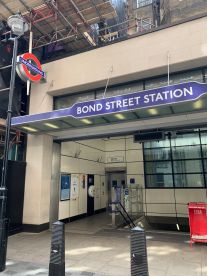 Marylebone Lane runs to Oxford Street, meeting it at Bond Street Underground station and it is there where Plague opens (Prologue aside). Cassandra, our heroine, arrives there to take part in an assessment of a large infrastructure project – the creation of the extension to Bond Street Station to allow for the building of the Elizabeth Line (also known as Crossrail). We found the building site, south of Oxford Street, just along Davies Street, as the works are still ongoing, though are now well advanced. We walked along Davies Street, with only a brief digression into a nearby antique market, into Davies Mews and South Molton Lane tracing the river’s course as much as we could.
Marylebone Lane runs to Oxford Street, meeting it at Bond Street Underground station and it is there where Plague opens (Prologue aside). Cassandra, our heroine, arrives there to take part in an assessment of a large infrastructure project – the creation of the extension to Bond Street Station to allow for the building of the Elizabeth Line (also known as Crossrail). We found the building site, south of Oxford Street, just along Davies Street, as the works are still ongoing, though are now well advanced. We walked along Davies Street, with only a brief digression into a nearby antique market, into Davies Mews and South Molton Lane tracing the river’s course as much as we could.
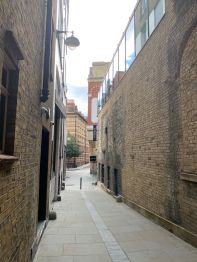 Following a hidden river on foot makes one reconsider the topography of the land. I had always thought of central London as flat, but I began to see the small undulations and gradients beneath the buildings and the streets. A river will always run downhill and follow the easiest, and lowest, course, so we found ourselves noticing the slightest of gradients – something, I’d guess, cyclists notice all the time. This lead us to explore all sorts of hidden byways and discover all sorts of interesting oddities – Sotheby’s storage warehouse, for example, or charming little quiet back streets and mews.
Following a hidden river on foot makes one reconsider the topography of the land. I had always thought of central London as flat, but I began to see the small undulations and gradients beneath the buildings and the streets. A river will always run downhill and follow the easiest, and lowest, course, so we found ourselves noticing the slightest of gradients – something, I’d guess, cyclists notice all the time. This lead us to explore all sorts of hidden byways and discover all sorts of interesting oddities – Sotheby’s storage warehouse, for example, or charming little quiet back streets and mews.
There were more famous places too and, whilst there were 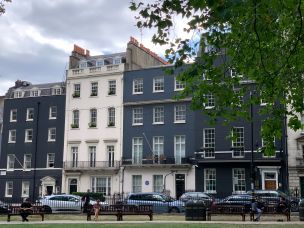 no nightingales in Berkeley Square, there were plenty of folk enjoying sitting in the sunshine. Like St Peters, the Georgian buildings around this Square are identified as potential crime scenes in Plague. We resisted the call of the garden benches and pressed on into Curzon Street and the Third Church of Christ Scientist. This is the scene of a murder in the novel and Cassie is summoned there on a Saturday night.
no nightingales in Berkeley Square, there were plenty of folk enjoying sitting in the sunshine. Like St Peters, the Georgian buildings around this Square are identified as potential crime scenes in Plague. We resisted the call of the garden benches and pressed on into Curzon Street and the Third Church of Christ Scientist. This is the scene of a murder in the novel and Cassie is summoned there on a Saturday night.
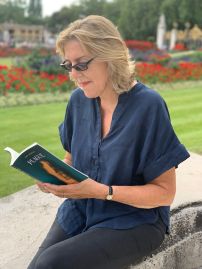 It’s also where Spikey Fullman, gentleman of the road, comes to the police’s aid as their first potential witness, having had his sleeping place down a set of side stairs to the side of the church disturbed. We followed the river’s course, running beneath Half Moon Street into Green Park, where Cassie and Andrew, her police colleague, meet with sewer-man extraordinaire, George Bindel, to begin their underground journey. Across the green space to Buckingham Palace and into St James’ Park, we took a short break, with ice cream, outside Buckingham Palace, which was also an opportunity for me to check in with the novel.
It’s also where Spikey Fullman, gentleman of the road, comes to the police’s aid as their first potential witness, having had his sleeping place down a set of side stairs to the side of the church disturbed. We followed the river’s course, running beneath Half Moon Street into Green Park, where Cassie and Andrew, her police colleague, meet with sewer-man extraordinaire, George Bindel, to begin their underground journey. Across the green space to Buckingham Palace and into St James’ Park, we took a short break, with ice cream, outside Buckingham Palace, which was also an opportunity for me to check in with the novel.
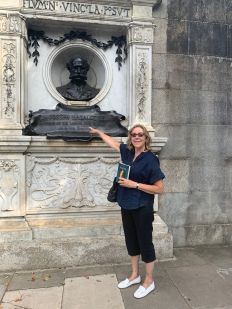 St James Park was a delight and as peaceful as Cassie finds it in Plague, before she runs into the demonstration spilling over from Whitehall as she crosses Horseguards Parade. We walked through the Horseguards arch, across Whitehall to the Thames, so that we could visit the memorial to Sir Joseph Bazalgette, that remarkable Victorian engineer and hero of George Bindel, who built most of London’s sewers. It is there, on Bazalgette’s Victoria Embankment that this piece will end, though I’ll be posting on the remainder of our walk soon.
St James Park was a delight and as peaceful as Cassie finds it in Plague, before she runs into the demonstration spilling over from Whitehall as she crosses Horseguards Parade. We walked through the Horseguards arch, across Whitehall to the Thames, so that we could visit the memorial to Sir Joseph Bazalgette, that remarkable Victorian engineer and hero of George Bindel, who built most of London’s sewers. It is there, on Bazalgette’s Victoria Embankment that this piece will end, though I’ll be posting on the remainder of our walk soon.
The Book Walk Continues… ‘With an address like that you must be very wealthy’ Bookwalk Out takes Going Underground
For more about Plague and the writing of it read The Plague story continues and Stranger than fiction. Plague is published on 15th September by Claret Press, cost £9.99.